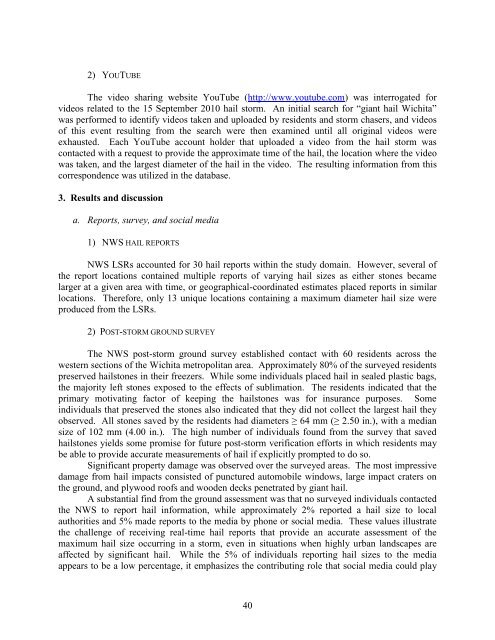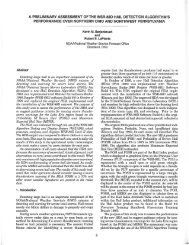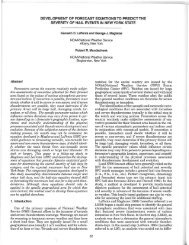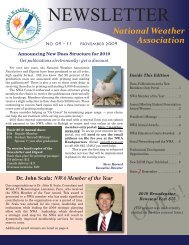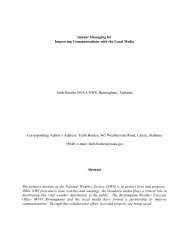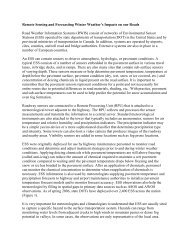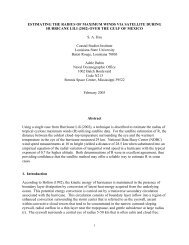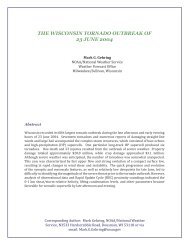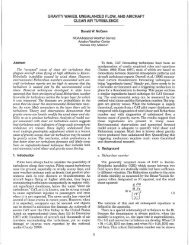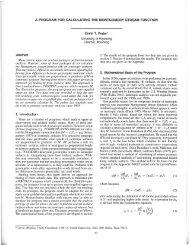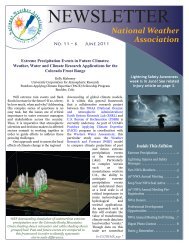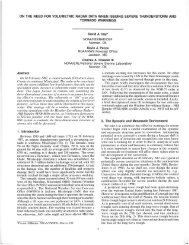Creating high-resolution hail datasets using social media and post ...
Creating high-resolution hail datasets using social media and post ...
Creating high-resolution hail datasets using social media and post ...
Create successful ePaper yourself
Turn your PDF publications into a flip-book with our unique Google optimized e-Paper software.
2) YOUTUBE<br />
The video sharing website YouTube (http://www.youtube.com) was interrogated for<br />
videos related to the 15 September 2010 <strong>hail</strong> storm. An initial search for “giant <strong>hail</strong> Wichita”<br />
was performed to identify videos taken <strong>and</strong> uploaded by residents <strong>and</strong> storm chasers, <strong>and</strong> videos<br />
of this event resulting from the search were then examined until all original videos were<br />
exhausted. Each YouTube account holder that uploaded a video from the <strong>hail</strong> storm was<br />
contacted with a request to provide the approximate time of the <strong>hail</strong>, the location where the video<br />
was taken, <strong>and</strong> the largest diameter of the <strong>hail</strong> in the video. The resulting information from this<br />
correspondence was utilized in the database.<br />
3. Results <strong>and</strong> discussion<br />
a. Reports, survey, <strong>and</strong> <strong>social</strong> <strong>media</strong><br />
1) NWS HAIL REPORTS<br />
NWS LSRs accounted for 30 <strong>hail</strong> reports within the study domain. However, several of<br />
the report locations contained multiple reports of varying <strong>hail</strong> sizes as either stones became<br />
larger at a given area with time, or geographical-coordinated estimates placed reports in similar<br />
locations. Therefore, only 13 unique locations containing a maximum diameter <strong>hail</strong> size were<br />
produced from the LSRs.<br />
2) POST-STORM GROUND SURVEY<br />
The NWS <strong>post</strong>-storm ground survey established contact with 60 residents across the<br />
western sections of the Wichita metropolitan area. Approximately 80% of the surveyed residents<br />
preserved <strong>hail</strong>stones in their freezers. While some individuals placed <strong>hail</strong> in sealed plastic bags,<br />
the majority left stones exposed to the effects of sublimation. The residents indicated that the<br />
primary motivating factor of keeping the <strong>hail</strong>stones was for insurance purposes. Some<br />
individuals that preserved the stones also indicated that they did not collect the largest <strong>hail</strong> they<br />
observed. All stones saved by the residents had diameters ≥ 64 mm (≥ 2.50 in.), with a <strong>media</strong>n<br />
size of 102 mm (4.00 in.). The <strong>high</strong> number of individuals found from the survey that saved<br />
<strong>hail</strong>stones yields some promise for future <strong>post</strong>-storm verification efforts in which residents may<br />
be able to provide accurate measurements of <strong>hail</strong> if explicitly prompted to do so.<br />
Significant property damage was observed over the surveyed areas. The most impressive<br />
damage from <strong>hail</strong> impacts consisted of punctured automobile windows, large impact craters on<br />
the ground, <strong>and</strong> plywood roofs <strong>and</strong> wooden decks penetrated by giant <strong>hail</strong>.<br />
A substantial find from the ground assessment was that no surveyed individuals contacted<br />
the NWS to report <strong>hail</strong> information, while approximately 2% reported a <strong>hail</strong> size to local<br />
authorities <strong>and</strong> 5% made reports to the <strong>media</strong> by phone or <strong>social</strong> <strong>media</strong>. These values illustrate<br />
the challenge of receiving real-time <strong>hail</strong> reports that provide an accurate assessment of the<br />
maximum <strong>hail</strong> size occurring in a storm, even in situations when <strong>high</strong>ly urban l<strong>and</strong>scapes are<br />
affected by significant <strong>hail</strong>. While the 5% of individuals reporting <strong>hail</strong> sizes to the <strong>media</strong><br />
appears to be a low percentage, it emphasizes the contributing role that <strong>social</strong> <strong>media</strong> could play<br />
40


